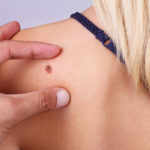Melanoma And Marriage

When melanoma occurs, married people are more likely to be diagnosed earlier in the disease process than the unmarried, probably because their spouses spot the telltale signs of this most serious form of skin cancer. To reach this conclusion, researchers analyzed just over 52,000 (patients diagnosed with melanoma between 2010 and 2014. They found that among married patients, nearly 47 percent had the smallest, earliest stage and most treatable cancers compared with 43 percent of unmarried patients, 39 percent of divorced and 32 percent of widowed patients. The researchers suggested that spouses might be more likely to notice suspicious moles on their partners and more inclined to nag them to get the growths examined. The study also found that never married patients were 12 percent more likely to have a later stage cancer when diagnosed, while the divorced were 34 percent more likely and the widowed twice as likely. If you’re not married, the researchers suggested asking relatives or friends to check you for moles periodically or to regularly see a dermatologist to perform skin checks.
My take? Whether or not you have a vigilant spouse, I suggest following the Skin Cancer Foundation’s advice: have a yearly skin exam by a doctor and check your own skin once a month for any changes. Look everywhere on your body – your head and face (use mirrors) and even your scalp (you can use a comb or blow-dryer to separate your hair). Also check your hands and fingernails, elbows, arms and underarms, your neck, chest and torso. Women should look under their breasts. Use a hand mirror to check the back of your neck, shoulders, upper arms, back, buttocks and legs and then sit down and check your legs and feet, including the soles, heels and nails. Also use a hand mirror to examine your genitals.
Source:
Cimarron E. Sharon and Giorgios C. Karakousis et al, “Association of Marital Status With T Stage at Presentation and Management of Early-Stage Melanoma.” JAMA Dermatology, April 18, 2018, doi:10.1001/jamadermatol.2018.0233
Also in this week’s bulletin:











